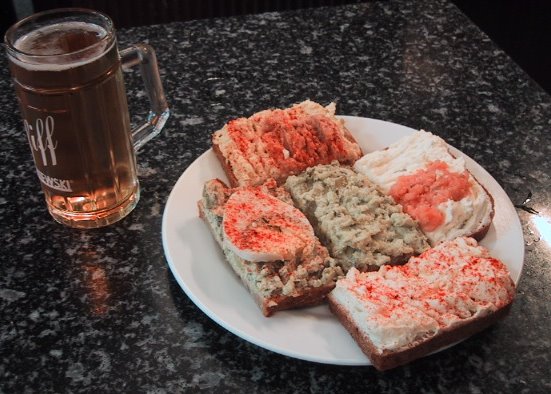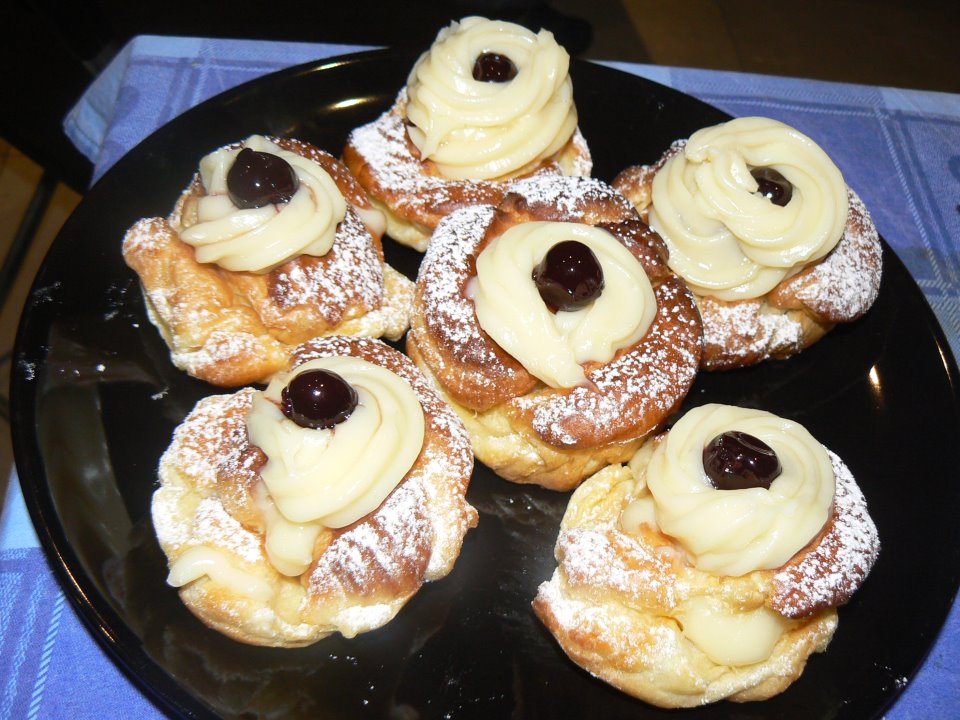|
Fried Dough
Fried dough is a North American food associated with outdoor food stands in carnivals, amusement parks, fairs, rodeos, and seaside resorts. "Fried dough" is the specific name for a particular variety of fried bread made of a yeast dough; see the accompanying images for an example of use on carnival-booth signs. Fried dough is also known as fry dough, fry bread ( bannock), fried bread, doughboys, elephant ears, beaver tails, scones, pizza fritte, frying saucers (in the case of smaller pieces). These foods are virtually identical to each other and some yeast dough versions of beignets, and recognizably different from other fried dough foods such as doughnuts or fritters. Regional variants In Canadian cuisine, pieces of fried dough are sometimes called . According to Bill Castleman, a writer of books on Canadian word origins, the name referred to quick-baked dough "especially in early 19th-century places where people might camp for one night and where there was no fryin ... [...More Info...] [...Related Items...] OR: [Wikipedia] [Google] [Baidu] |
New London, Connecticut
New London is a seaport city and a port of entry on the northeast coast of the United States, located at the outlet of the Thames River (Connecticut), Thames River in New London County, Connecticut, which empties into Long Island Sound. The city is part of the Southeastern Connecticut Planning Region, Connecticut, Southeastern Connecticut Planning Region. New London is home to the United States Coast Guard Academy, Connecticut College, Mitchell College, and The Williams School. The Coast Guard Station New London and New London Harbor is home port to both the Coast Guard's Cutter (boat), cutter ''Coho'' and their tall ship USCGC Eagle (WIX-327), ''Eagle''. The city had a population of 27,367 at the 2020 census. The Norwich, Connecticut, Norwich–New London metropolitan area includes 21 towns and 274,055 people. History Colonial era The area was called Nameaug by the Pequot Native Americans of the United States, Indians. John Winthrop, Jr. founded the first English settlemen ... [...More Info...] [...Related Items...] OR: [Wikipedia] [Google] [Baidu] |
BeaverTails
BeaverTails is a Canadian restaurant chain, specializing in pastries known as BeaverTails, that is operated by BeaverTails Canada Inc. Its namesake products are fried dough pastries, individually hand-stretched to resemble beaver's tails, with various toppings added on the pastry. The chain originated in Killaloe, Ontario in 1978 and opened its first permanent store in Ottawa two years later. By 2018, it had 140 franchise and licence locations in six countries: Canada (the Maritimes, Newfoundland and Labrador, Ontario, Manitoba, Alberta, British Columbia and Quebec, where the franchise is called Queues de Castor), the United States (New Hampshire, Michigan, Wisconsin, Tennessee, Arkansas and Utah), the United Arab Emirates, Mexico, France, and Japan. Company history BeaverTails began when Grant and Pam Hooker turned their family recipe for fried dough into a corporate business. They sold their first pastries at the Killaloe Craft and Community Fair in 1978. Two years later ... [...More Info...] [...Related Items...] OR: [Wikipedia] [Google] [Baidu] |
Austrian Cuisine
Austrian cuisine consists of many different local or regional cuisines. In addition to Viennese cuisine, which is predominantly based on the cooking traditions of the Habsburg monarchy, Habsburg Empire, there are independent regional traditions in all the Federal states of Austria, states of Austria. The Austrian cuisine shares similarities with its neighboring countries in Central Europe, but particularly with the cuisines of Hungarian cuisine, Hungary, Bavaria, Bohemia and Northern Italy. Dishes and preparation methods have often been adopted, integrated, adapted or mixed. The Austrian cuisine is internationally known above all for its pastries such as the Kaiserschmarrn, the apple strudel, as well as for the Tafelspitz and the Wiener schnitzel. Mealtimes Breakfast is of the "continental" type, usually consisting of Kaiser roll, bread rolls with either jam or cold meats and cheese, like most of european cuisine and it is accompanied by coffee, tea or juice. The midday me ... [...More Info...] [...Related Items...] OR: [Wikipedia] [Google] [Baidu] |
Lángos
Lángos () is a typical Hungarian food. Nowadays it is a deep fried flatbread, but in the past it was made of the last bits of the bread-dough and baked at the front of a brick or clay oven, to be served hot as the breakfast of the bread-baking day.June Meyers Authentic Hungarian Heirloom Recipes Cookbook Etymology and history The name comes from ''láng'', the Hungarian language, Hungarian word for flame. Up to the mid 20th century, bread was baked once a week due to the cost of heating up the large oven and the lengthy process kneading up to of dough. Because the bread loaf, typical to Hungary, was each, traditionally they used to bake smaller () "cipó" rolls for the evening and the next day. The name lángos (meaning "flamed") comes from baking these flat breads in the morning while the oven was still heating up. "Lángos" were also used as a side to lunch. Variations The dough for lángos is made of water or milk, flour, Baker's yeast, yeast, and salt. The ingredient ... [...More Info...] [...Related Items...] OR: [Wikipedia] [Google] [Baidu] |
Hungarian Cuisine
Hungarian or Magyar cuisine (Hungarian language, Hungarian: ''Magyar konyha'') is the cuisine characteristic of the nation of Hungary, and its primary ethnic group, the Hungarians, Magyars. Hungarian cuisine has been described as being the Pungency, spiciest cuisine in Europe. This can largely be attributed to the use of their piquant native spice, Paprika#Hungarian, Hungarian paprika, in many of their dishes. A mild version of the spice, Hungarian sweet paprika, is commonly used as an alternative. Traditional Hungarian dishes are primarily based on meats, seasonal vegetables, fruits, bread, and dairy products. General features Paprika is often associated with Hungary and is used prominently in several dishes. Traditional Hungarian paprika is characterised by its bright colour and distinct heat, differentiating it from milder variations of paprika popular elsewhere in the world. Other herbs and spices commonly used in Hungarian cuisine include garlic, marjoram, Caraway, cara ... [...More Info...] [...Related Items...] OR: [Wikipedia] [Google] [Baidu] |
Croatian Cuisine
Croatian cuisine () is heterogeneous and is known as a cuisine of the regions, since every region of Croatia has its own distinct culinary tradition. Its roots date back to Classical Antiquity, ancient times. The differences in the selection of foodstuffs and forms of cooking are most notable between those in mainland and those in coastal regions. Mainland cuisine is more characterized by Slavic features and influences from the more recent contacts with Turkish cuisine, Turkish, Hungarian cuisine, Hungarian and Austrian cuisine, Austrian cuisine, using lard for cooking, and spices such as black pepper, paprika, and garlic. The coastal region bears the influences of Greek cuisine, Greek and Roman cuisine, Roman cuisine, as well as of the later Mediterranean cuisine, in particular Italian cuisine, Italian (especially Venetian). Coastal cuisines use olive oil, herbs and spices such as rosemary, Salvia officinalis, sage, bay leaf, oregano, marjoram, cinnamon, clove, nutmeg, and lemon a ... [...More Info...] [...Related Items...] OR: [Wikipedia] [Google] [Baidu] |
Zeppole
Zeppole (; : ''zeppola'') are Italian pastries consisting of a deep-fried dough ball of varying size but typically about in diameter. These fritters are usually topped with powdered sugar, and may be filled with custard, jelly, cannoli-style pastry cream or a butter-and-honey mixture. The consistency ranges from light and puffy, to bread- or pasta-like. They are eaten to celebrate Saint Joseph's Day, which is a Catholic feast day. History Zeppole are typical of Italian cuisine, especially that of Rome, Naples, and Lecce. They originated in ancient Rome, when people started frying dough and putting sugar or cinnamon on it. However, the zeppole that is around today was created in the 18th century. These zeppole either have sugar, cinnamon or chocolate with them. They are also served in Sicily, on the island of Malta, and in Italian communities in Canada and the United States. The Sardinian , although they are often italianized to ''zeppole'', are somewhat different. ''Zipp ... [...More Info...] [...Related Items...] OR: [Wikipedia] [Google] [Baidu] |
Italian Cuisine
Italian cuisine is a Mediterranean cuisine#CITEREFDavid1988, David 1988, Introduction, pp. 101–103 consisting of the ingredients, recipes, and cooking techniques developed in Italy since Ancient Roman cuisine, Roman times, and later spread around the world together with waves of Italian diaspora. Significant changes Columbian exchange, occurred with the colonization of the Americas and the consequent introduction of potatoes, tomatoes, capsicums, and maize, as well as sugar beet—the latter introduced in quantity in the 18th century. It is one of the best-known and most widely appreciated Gastronomy, gastronomies worldwide. Italian cuisine includes deeply rooted traditions common throughout the country, as well as all the diverse Regional cuisine, regional gastronomies, different from each other, especially between Northern Italy, the north, Central Italy, the centre, and Southern Italy, the south of Italy, which are in continuous exchange. Many dishes that were once region ... [...More Info...] [...Related Items...] OR: [Wikipedia] [Google] [Baidu] |
Corn Syrup
Corn syrup is a food syrup that is made from the starch of corn/maize and contains varying amounts of sugars: glucose, maltose and higher oligosaccharides, depending on the grade. Corn syrup is used in foods to soften Mouthfeel, texture, add volume, prevent crystallization of sugar, and enhance flavor. Most table syrups are typically based with corn syrup. It can be processed into high-fructose corn syrup (HFCS) by using the enzyme xylose isomerase, D-xylose isomerase to convert a large proportion of its glucose into sweeter fructose. The more general term glucose syrup is often used synonymously with corn syrup, since glucose syrup in the United States is most commonly made from corn starch. Technically, glucose syrup is any liquid starch hydrolysis, hydrolysate of mono-, di-, and higher-saccharides and can be made from any source of starch: wheat, tapioca and potatoes are the most common other sources. Commercial preparation Historically, corn syrup was produced by combining ... [...More Info...] [...Related Items...] OR: [Wikipedia] [Google] [Baidu] |
Maple Syrup
Maple syrup is a sweet syrup made from the sap of maple trees. In cold climates, these trees store starch in their trunks and roots before winter; the starch is then converted to sugar that rises in the sap in late winter and early spring. Maple trees are tapped by drilling holes into their trunks and collecting the sap, which is processed by heating to evaporate much of the water, leaving the concentrated syrup. Maple syrup was first made by the Indigenous peoples of North America, Indigenous peoples of Northeastern North America. The practice was adopted by European settlers, who gradually changed production methods. Technological improvements in the 1970s further refined syrup processing. Almost all of the world's maple syrup is produced in Canada and the United States. Maple syrup is graded based on its colour and taste. Sucrose is the most prevalent sugar in maple syrup. In Canada, syrups must be made exclusively from maple sap to qualify as maple syrup and must also be ... [...More Info...] [...Related Items...] OR: [Wikipedia] [Google] [Baidu] |
Molasses
Molasses () is a viscous byproduct, principally obtained from the refining of sugarcane or sugar beet juice into sugar. Molasses varies in the amount of sugar, the method of extraction, and the age of the plant. Sugarcane molasses is usually used to sweeten and flavour foods. Molasses is a major constituent of fine commercial brown sugar. Molasses is rich in vitamins and minerals, including vitamin B6, iron, calcium, magnesium, and potassium. There are different types of molasses depending on the amount of time refined, including first molasses (highest sugar content), second molasses (slightly bitter), and blackstrap molasses (the darkest and most robust in flavor). Molasses was historically popular in the Americas before the 20th century as a sweetener. It is still commonly used in traditional cuisine, such as in Madeira Island's traditional dishes. In addition to culinary uses, molasses has industrial applications, such as in the distillation of rum, as an additiv ... [...More Info...] [...Related Items...] OR: [Wikipedia] [Google] [Baidu] |






